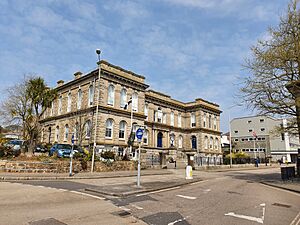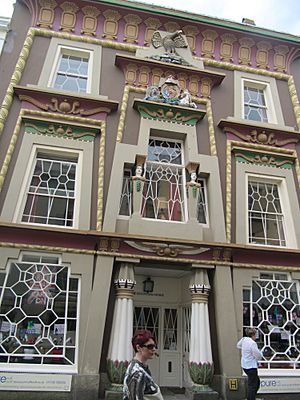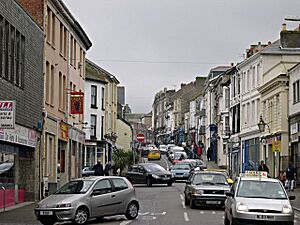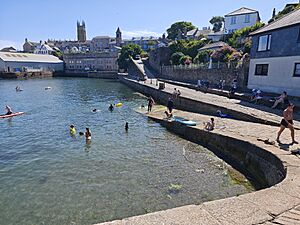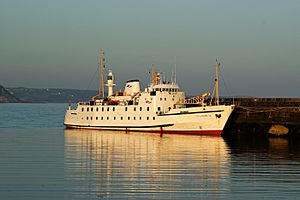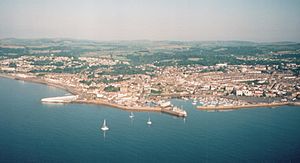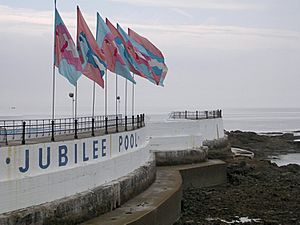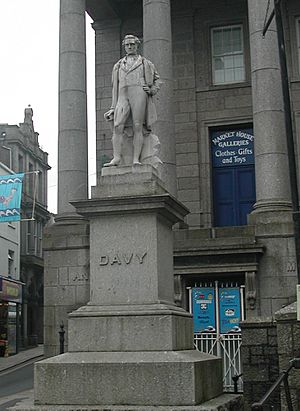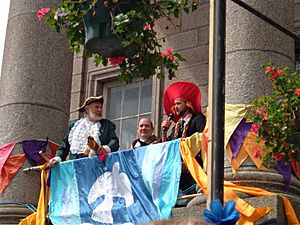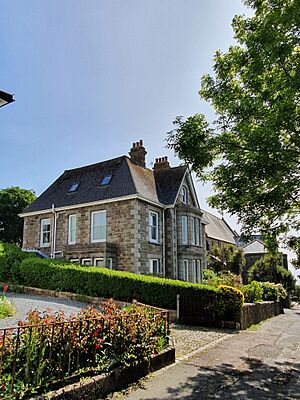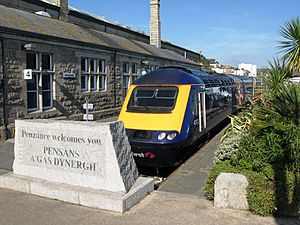Penzance facts for kids
Quick facts for kids Penzance
|
|
|---|---|
| Town | |
 A panorama of Penzance |
|
The council's logo |
|
| Lua error in Module:Location_map at line 530: Unable to find the specified location map definition: "Module:Location map/data/Cornwall (mainland)" does not exist. | |
| Population | 21,200 (2011) |
| OS grid reference | SW475306 |
| Civil parish |
|
| Unitary authority | |
| Ceremonial county | |
| Region | |
| Country | England |
| Sovereign state | United Kingdom |
| Post town | PENZANCE |
| Postcode district | TR18 |
| Dialling code | 01736 |
| Police | Devon and Cornwall |
| Fire | Cornwall |
| Ambulance | South Western |
| EU Parliament | South West England |
| UK Parliament |
|
| Website | www.penzance-tc.gov.uk |
Penzance (pronounced pen-ZANSS) is a town, parish, and port in Cornwall, England. It's the most western major town in Cornwall. Penzance is about 64 miles (103 km) west-southwest of Plymouth and 255 miles (410 km) west-southwest of London. The town sits safely in Mount's Bay, facing the English Channel. To its west is the fishing port of Newlyn, to the north is Madron, and to the east is Ludgvan. The Penzance parish also includes Newlyn and the villages of Mousehole, Paul, Gulval, and Heamoor. Penzance received special royal permissions (charters) starting in 1512 and became an official town on May 9, 1614. In 2011, its population was 21,200 people.
Penzance's old main street, Chapel Street, has many interesting buildings. These include the Egyptian House and The Admiral Benbow pub. This pub was once home to a real smuggling gang in the 1800s. It's even said to have inspired the "Admiral Benbow Inn" in the book Treasure Island. The Union Hotel has an old Georgian theatre that is no longer used. Branwell House was where the mother and aunt of the famous Brontë sisters (who wrote books like Jane Eyre) once lived. Many buildings in town show off Regency and Georgian designs.
The nearby sub-tropical Morrab Gardens is a special place. It has a huge collection of delicate trees and plants. Many of these can't grow outdoors anywhere else in the UK. The seafront is also interesting with its long promenade. You can also find the open-air seawater Jubilee Pool there. It's one of the oldest surviving Art Deco swimming pools in the country.
Penzance is famous for being the home of the pirates in the funny opera The Pirates of Penzance by Gilbert and Sullivan. When the story was written in 1879, Penzance was known as a quiet holiday town. So, the idea of it being full of pirates was quite amusing to people back then!
Contents
What's in a Name?
The name Penzance comes from the Cornish language words Pennsans. This means "holy headland". It refers to a chapel that stood over a thousand years ago. This chapel, possibly dedicated to St Anthony, was on the headland west of where Penzance Harbour is now. The only part left from this old chapel is a carved stone figure. It's called "St Raffidy" and can be found in the churchyard of St Mary's Church. Until the 1930s, the town's symbol was a severed "holy head". This was the head of St John the Baptist. You can still see his head on the Mayor of Penzance's special items and on the north side of the Market House.
Penzance Through Time
Early Days
Long ago, about 400 stone axes were found across Britain. These axes were made from greenstone and likely came from west Cornwall, near Penzance. This shows that people traded a lot back then. The first signs of people living in Penzance are from the Bronze Age. Bronze tools and pottery were found when new houses were built.
An old defensive earthwork called Lescudjack Castle is also in the area. It was probably built in the Iron Age. This fort would have protected the area from the east. Even though there's no strong proof, some Roman coins have been found in Penzance. This suggests that Romans might have visited the area.
The area where Penzance is now was part of a large estate called the Manor of Alverton. This manor was owned by a Saxon named Alward before the Norman Conquest in 1066. After the Normans took over, it was given to Robert, Count of Mortain.
Medieval Times
The name Pensans first appeared in records in 1284. The old chapel that gave Penzance its name was mentioned in 1750. It was a small chapel made of greenstone. Later, it was used as a fish cellar. The carved stone figure of "St Raffidy" was moved to St Mary's Churchyard. Experts believe it dates back to the early 12th century.
The current St Mary's Church stands tall above the harbour. A St Mary's Chapel was mentioned in 1548. It was likely a "chapel of ease," meaning people used it for services but not for Sunday worship. This helped make sure people still went to the main Parish Church in Madron.
Growing Economy
In medieval times, towns needed special permission from the king to hold markets and fairs. These events were important for trade. King Edward III allowed Penzance to have a market every Wednesday in 1332. Later, King Henry IV added three more fairs.
It's not clear when Penzance built its first quay (a place for ships to dock). But records from 1322 show that there were eight fishing boats in Penzance. This number grew to 13 by 1327. This shows that Penzance was becoming an important fishing town. Ships from Penzance were even allowed to carry pilgrims to a holy site in Spain in the 1400s.
Penzance was often attacked by "Turkish pirates" (actually Barbary Corsairs) during the Middle Ages.
Early Modern Period
Tudor Times
In the summer of 1578, the plague hit Penzance. The number of deaths in the area jumped from 12 to 155 in one year. This was about 10% of the town's population. The plague returned in 1647, causing another big increase in deaths.
On July 23, 1595, a Spanish force landed in Cornwall. They attacked and burned Penzance and nearby villages. The local soldiers ran away in fear. Only a few people tried to fight back.
Penzance Becomes a Town
Penzance became more successful when King Henry IV gave it a royal market in 1404. King Henry VIII allowed the town to charge fees for using its harbour in 1512. Then, in 1614, King James I made Penzance an official Borough. This meant the town could govern itself. It could own land, collect fines, and have its own court. The town also got two weekly markets and several fairs.
The town bought its freedom from the Manor of Alverton in 1615. This gave Penzance even more control over its own affairs. A market house and town hall were built. The southern part of the pier was built in 1766 and made longer in 1785.
During the English Civil War, Penzance was attacked by Parliamentarian forces. This was because the town had been kind to the Royalist troops.
In 1759, a water system was built to supply public pumps in the streets. In 1768, a friendly society for tradesmen was formed. Members helped each other if they were sick or needed money for funerals.
Penzance has always been closely linked to the nearby parish of Madron. Madron Church was the main religious center until 1871. That's when St Mary's Church in Penzance became its own parish.
The 1755 Sea Wave
On November 1, 1755, a huge earthquake in Lisbon, Portugal, caused a large wave (called a seiche) along the Cornish coast. At about 2:00 pm, the sea in Penzance rose 8 feet (2.4 m) very quickly. It then fell just as fast. Luckily, not much damage was caused.
The 1800s
At the start of the 1800s (1801), Penzance had 2,248 people. By 1861, the population reached its highest point at 3,843. But then it went down, like in many parts of Cornwall, to 3,088 in 1901.
By the time Queen Victoria became queen in 1837, Penzance was an important regional center. The Royal Geological Society of Cornwall was started in Penzance in 1814. They helped create a safer tool for miners.
Cornwall's first lifeboat was bought by Penzance in 1803. But it was sold in 1812 because there wasn't enough money to keep it going. The pier was made longer again in 1812. A small dry dock, the first in the South West, opened in 1814. These helped support the steamships that started coming to the harbour.
Gas lighting came to Penzance in 1830. The old Market House was taken down in 1836. A new one, designed by W. Harris, was finished in 1838. St Mary's Church was completed in 1836. The unique Egyptian House was built in 1830. The first part of the Promenade along the seafront was built in 1844.
The Railway Arrives
Penzance railway station opened on March 11, 1852. It was the end of the West Cornwall Railway line. At first, trains only went to Redruth. Later, the line reached Truro. But passengers had to change trains at Truro because the tracks were different sizes.
The railway line was sold to the Great Western Railway in 1866. They changed the tracks so both types of trains could run. Through passenger trains to London started in 1867. The last wide-track train arrived on May 20, 1892. Since then, all trains have used the standard track size.
The railway made it easy to send fresh food like potatoes, broccoli, and fish to cities like Bristol and London. This helped local farmers and fishermen earn more money. Fruit and flowers also went by train. The mild climate in Penzance meant they were ready earlier and could be sold for high prices.
The railway also made it easier for tourists to visit Penzance. The town was known for its pleasant location and good air. The first official guide book for Penzance was published in 1860. The Queen's Hotel opened on the seafront in 1861 and became very popular.
Harbour and Town Improvements
More improvements were made to the harbour. The Albert Pier was finished in 1853, giving ships even more shelter. The Old Pier was also made longer, and a lighthouse was built on it in 1855. This lighthouse is still used today.
The Scilly Isles Steam Navigation Company started in 1858. They used the first steamship, SS Little Western, for the route. The Royal National Lifeboat Institution also set up a lifeboat station in Penzance in 1853.
Penzance was chosen as the western base for Trinity House. This group looks after lighthouses and lightships. Their depot opened in 1866 next to the harbour.
The railway station was improved in the 1880s. The original building was rebuilt in 1880. Market Jew Street was made wider, and a new road with a Swing Bridge was built to connect the station to the harbour in 1881. This also allowed for proper sewers to be built. A larger dry dock was built in 1880. A floating harbour with lock gates was created in 1884 to keep water in at low tide.
Public baths opened on the Promenade in 1887. The Morrab Gardens with its sub-tropical plants opened two years later. A bandstand was added to the gardens in 1897.
The 1900s
In 1901, Penzance had 3,088 people. The population kept going down until 1921, when it was 2,616. But then it grew quickly, more than doubling in 30 years to 5,545 by 1951.
Instead of a tramway, motor buses started running in Penzance on October 31, 1903. These buses connected Penzance with Marazion, Land's End, and St Just. These bus services grew into the First Kernow network we see today.
In 1912, Penzance got its first electric street lamps. The town's first cinema also opened that year.
The dry dock was sold in 1904 to N. Holman and Sons Limited. They built new workshops in the 1930s. The dock was used by ferries to the Scilly Isles, other ships, and even the Royal Navy.
Land was added next to the Albert Pier in the 1930s. This allowed the railway station to be made bigger. Extra platforms and tracks were added for more goods and tourists.
A new bandstand was built on the Promenade in 1905. The Pavilion Theatre opened in 1911. Traveling to Penzance became easier than ever. The Great Western Railway started the Cornish Riviera Express in 1904. This train got from London to Penzance in just 7 hours, much faster than before.
In 1923, a new road connected the harbour and the Promenade. In 1933, the St. Anthony Gardens were built. Two years later, the Jubilee Pool opened. Tourists could now easily enjoy the whole seafront.
In the early 1990s, a bypass road was built around the town to help with traffic.
Getting Around Penzance
Trains
Penzance railway station is at the eastern end of Market Jew Street, close to the harbour. It's the most southern train station on the UK mainland! From the station, you get great views of St. Michael's Mount and Mount's Bay.
Two train companies run services from Penzance:
- Great Western Railway has local trains to places like St Erth and Truro. They also have longer-distance trains to Plymouth, Bristol, and London Paddington. The Night Riviera train offers an overnight service with sleeping cars to London.
- CrossCountry runs a few services each day to places like Birmingham, Sheffield, and Edinburgh. They even have a daily train from Aberdeen, which is the longest direct train service in the UK!
Buses
The bus and coach station is right next to the train station. National Express runs long-distance coach services to London. Local bus services by First Kernow connect Penzance to most towns in Cornwall, including St Ives, Land's End, and even Plymouth.
Roads
The A30 road goes from London all the way to Land's End. It bypasses Penzance to the north. The A30 connects Penzance to the M5 motorway at Exeter, about 111 miles (179 km) away. The distance from Penzance to London is about 275 miles (443 km).
Water Travel
A ferry service runs between Penzance Harbour and the Isles of Scilly. The Scillonian III carries both people and cargo. The trip takes about 2 hours and 40 minutes.
Air Travel
From 1964 to 2012, and again since 2020, Penzance Heliport has offered helicopter flights to the Isles of Scilly. A new heliport opened in 2020. It offers services to Tresco and St Mary's islands. A bus service connects the train station to Land's End Airport for small plane flights to the Isles of Scilly.
Newquay Airport is 41 miles (66 km) away. It offers flights to London and other places, including more and more European destinations.
How Penzance is Governed
Penzance used to be an "ancient borough." In 1835, it became a "municipal borough." In 1934, the borough grew to include nearby places like Newlyn, Paul, Mousehole, Gulval, and Heamoor.
In 1974, the Penzance Borough was ended. A new local council, called Penzance Town Council, was formed in 1980. This council helps manage services and amenities for the town. In 2009, the larger Penwith District Council was removed. Now, Cornwall Council is the main local authority. Penzance elects 6 members to Cornwall Council.
Penzance Town Council members don't officially belong to political groups. They technically act independently. The council elects a mayor every year in May. The mayor works with the Town Clerk and Cornwall Council to provide services for the town. The current mayor is Cllr. Stephen Reynolds.
Penzance's Economy
Like many places in Cornwall, Penzance's economy has changed. Old industries like fishing, mining, and farming have declined. Now, Penzance has a mix of light industry, tourism, and retail businesses. However, housing is still expensive, wages are low, and unemployment can be high.
The fishing port of Newlyn, which is part of the Penzance parish, provides some jobs. But it has also been affected by the decline in fishing. Some areas of Penzance have higher unemployment rates.
Mining History
Penzance has a long history with mining. The Miners' Association started mining classes in Penzance. The Penzance Mining and Science School was founded in 1890. It taught mining until 1910, when it joined with other schools to form the Camborne School of Mines.
From 1663, Penzance was a "coinage town." This meant it was responsible for collecting taxes on tin for the Duchy of Cornwall. Penzance collected more tin tax than many other towns combined!
Penzance even had its own underwater mine called Wheal Wherry Mine. It was worked from 1778 to 1798 and again from 1836 to 1840. This mine was said to be very rich. It was connected to the shore by a wooden bridge.
During the 1800s, Penzance had the biggest tin smelting house in Cornwall. This was run by the Bolitho family. Because of all this mining wealth, Penzance became a center for banking.
Places to See
Many parts of Penzance are protected as "conservation areas." This means they have special rules to keep their historic look. The town has many beautiful Georgian and Regency buildings. The Market Building (1836–38) has a grand Greek-style entrance with columns and a dome.
Chapel Street has interesting places like the Egyptian House and the Union Hotel. The Union Hotel's old Georgian theatre is where the first public announcement of Nelson's victory at the Battle of Trafalgar is said to have happened.
The sub-tropical Morrab Gardens has a huge collection of delicate trees and plants. Many of these can't grow outdoors anywhere else in the UK. The seafront has a long promenade and the open-air seawater Jubilee Pool. This pool was designed by Captain F. Latham and opened in 1935. It's a triangular pool with graceful curves and is considered one of the best examples of its kind. In 2018, work began to add a geothermal section to the pool, making it the first in the UK to use this technology.
Penzance promenade has been damaged by storms several times. In 1962, a big storm caused severe damage to the western end of the promenade and nearby areas. On the edge of town is Trereife House, a beautiful old manor house. It now offers accommodation and hosts events.
Weather in Penzance
Penzance has a mild, oceanic climate. This means it has cool summers and mild winters. It gets a fair amount of rain throughout the year. The town also gets a good amount of sunshine, especially from April to September.
| Climate data for Penzance, Penlee Gardens (1912–2003 averages) | |||||||||||||
|---|---|---|---|---|---|---|---|---|---|---|---|---|---|
| Month | Jan | Feb | Mar | Apr | May | Jun | Jul | Aug | Sep | Oct | Nov | Dec | Year |
| Mean daily maximum °C (°F) | 9 (48) |
9 (48) |
10 (50) |
11 (52) |
14 (57) |
16 (61) |
18 (64) |
18 (64) |
16 (61) |
14 (57) |
11 (52) |
10 (50) |
13 (55) |
| Mean daily minimum °C (°F) | 6 (43) |
5 (41) |
6 (43) |
7 (45) |
9 (48) |
12 (54) |
14 (57) |
14 (57) |
12 (54) |
11 (52) |
8 (46) |
7 (45) |
9 (49) |
| Average precipitation mm (inches) | 111.7 (4.40) |
83.4 (3.28) |
79.2 (3.12) |
67.5 (2.66) |
63.7 (2.51) |
58.9 (2.32) |
66.8 (2.63) |
66.1 (2.60) |
75.6 (2.98) |
107.2 (4.22) |
120.4 (4.74) |
119.0 (4.69) |
1,019.5 (40.15) |
| Mean monthly sunshine hours | 59.2 | 79.9 | 132.3 | 190.0 | 222.0 | 220.1 | 211.4 | 206.3 | 163.2 | 117.1 | 75.7 | 54.5 | 1,731.7 |
Schools in Penzance
Penzance has two main secondary schools: Mounts Bay Academy and Humphry Davy School. For older students (16+), there's Penwith College. The Penzance parish also has 8 primary schools. There's also a special needs school called Nancealverne.
Many other schools have existed in Penzance over time, including the West Cornwall School for Girls and Bolitho School. Bolitho School closed in 2017. The building is now being turned into a care home.
Culture and Fun
Every June since 1991, Penzance has held the Golowan Festival. This festival includes Mazey Day. The name "Golowan" comes from Cornish words meaning "Feast of St John." It celebrates midsummer.
Before the 1930s, Penzance had big May Day celebrations. Children would make and use tin "May horns." The feast day of Corpus Christi was also celebrated.
The summer solstice was celebrated with bonfires and fireworks. People would swing tar barrels through the streets. Allantide, a Cornish version of Halloween, was also popular.
In October 2010, the first Penzance Proms festival of music and arts was held. Every December, Penzance hosts the Montol Festival. This event brings back many old Cornish Christmas customs, like traditional costumes and mask dancing.
Music and Theatre
Penzance is famous for being the home of the pirates in the opera The Pirates of Penzance.
The Acorn Arts Centre offers a mix of theatre, film, dance, music, and comedy. The Savoy is an independent cinema that opened in 1912. It's said to be the oldest continuously used cinema in Britain!
Art Galleries
Penzance is home to "The Exchange," a new art gallery that opened in 2007. Penlee House is an art gallery and museum known for its collection of paintings by the Newlyn School artists. You can also find many other art galleries in Penzance town center.
Religion
Historically, Methodism was the main Christian religion in Penzance. Today, there are two Methodist churches. Penzance also has a The Salvation Army building, a Roman Catholic church, two Church of England churches, and other Christian groups. There's also a pagan group and a Buddhist meditation group.
St Mary's Church was built in 1832–35. St John's was built in 1881. Penzance used to be part of the Madron parish. But St Mary's parish was created in 1871.
An old Cornish cross used to stand in front of the Market House. It was moved several times and is now at Penlee House.
Sports and Activities
Penzance is home to Cornwall's most successful rugby team, the Cornish Pirates. They play at the Mennaye Field. The club has twice reached the play-off final to try and get into the top league of English rugby.
Penzance A.F.C. is the local football club. They were one of the first members of the Cornwall County Football Association. They have won the Cornwall Senior Cup ten times.
Former England cricketer Jack Richards was born in Penzance. He learned to play cricket with the Humphry Davy Grammar School and Penzance Cricket Club. The cricket club was founded in 1829 and is Cornwall's most successful club.
Penzance Wheelers is Britain's most south-westerly cycling club. It was founded in the 1930s. Tom Southam, who rode for Great Britain in five World Championships, was a member. Mount's Bay Harriers is a running and triathlon club based in Heamoor. Other sports clubs include Penzance Hockey Club, Penzance Tennis Club, and lawn bowling clubs.
Penzance was the starting point for the Mini Transat 6.50 transatlantic yacht race from 1977 to 1983.
Cornish Wrestling
Penzance has been a major center for Cornish wrestling for hundreds of years. Tournaments were held in many places around the town. The oldest known Cornish wrestling champion was Stanton, from the 1400s.
W Sampson, from Penzance, was the Cornish wrestling champion of Toronto in 1907. Earnest Small, also from Penzance, was the West of England champion in 1906.
Media
The local newspaper is The Cornishman, published every week.
Local news and TV shows come from BBC South West and ITV West Country.
Local radio stations include BBC Radio Cornwall (103.9 FM) and Coast FM (96.5 and 97.2 FM), which is a community radio station based in Penzance. You can also listen to Pirate FM (102.8 FM) and Heart West (107.0 FM).
Folklore
Long ago, people avoided the Eastern Green area between Marazion and Penzance. This was because of the "White Lady". She was said to jump onto a horse with a rider and ride along to the Red River. No one knows who she was or why she haunted the area.
Cornish Language
When you arrive at Penzance train station, you'll see a sign in both Cornish and English.
Famous People from Penzance
Many notable people have lived in Penzance. These include actress Thandiwe Newton, model Jean Shrimpton, and cricketer Jack Richards. Penzance was also the birthplace of Maria Branwell. She was the mother of the famous writers Charlotte Brontë, Emily Brontë, and Anne Brontë.
Sir Humphry Davy
Penzance was the birthplace of the famous chemist Sir Humphry Davy. He was the President of the Royal Society. He invented the process of electrolysis and was the first person to separate sodium. He also discovered nitrous oxide. Today, he is best known for inventing the Miner's Safety Lamp, or Davy lamp. You can see a statue of Davy at the top of Market Jew Street, near his birthplace. One of Penzance's secondary schools is also named after him.
Sister Cities
Penzance is connected with the following towns around the world:
- Concarneau, Brittany, France
- Bendigo, Victoria, Australia
- Nevada City, California, United States
- Cuxhaven, Germany (since 1967)
Freedom of the Town
The "Freedom of the Town" is a special honor given to people and military units.
Individuals
- April 25, 1958: Sir Edward Bolitho, who was the Lord Lieutenant of Cornwall from 1936 to 1962.
Military Units
- HMS Penzance, a ship of the RN: 2000.
See also
 In Spanish: Penzance para niños
In Spanish: Penzance para niños


